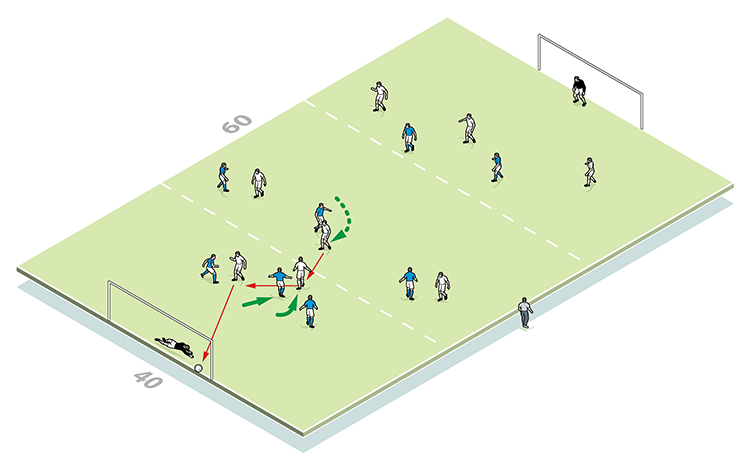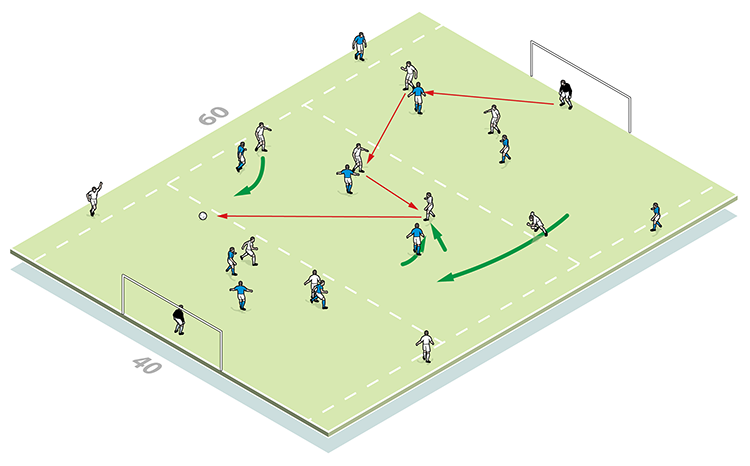Picking the right pass forward
Teach your team the benefit of positive forward play with this 8v8 passing session, which reinforces a positive attacking mindset and increases the opportunity to score goals.

| Area | 60x40 yards |
| Equipment | Balls, cones, goals |
| No. of Players | 16 |
| Session Time | Session 20mins, Progression 30mins |
This is an 8v8 passing session, plus keepers, that aims to teach teams the benefit of positive forward play.
For me, the notion of passing the ball forwards and making the right choice of pass is central to a good understanding of the game. It reinforces a positive attacking mindset and, of course, increases the opportunity to score goals.
This session progresses by subtly changing the parameters throughout, and we’re constantly looking for players to change and adapt their play in order to maximise attacking options.
What do I get the players to do?
We divide a 60x40-yard area into three equal sections, with a full-size goal at each end. There is a plentiful supply of balls. Defenders must remain in their sections at all times, but for other outfield positions it’s free play.
The coach stands off the pitch at half way, and serves the first ball into any of the three areas. If it goes to a defender, he must pass through to the middle third (1a) for an attacking move to build (1b). Should the ball go straight to a midfielder, he must pass into the final third, while a ball arriving at the feet of a striker can be fired at goal straight away. There should be no backwards passing.
1a

1b

If, from an attack, a keeper takes possession, he passes to a defender (1c); while if the ball goes out of play, the coach serves a new one in.
1c

What are the key things to look out for?
We look for players passing quickly and receiving on the half turn, and make sure they’re looking for team mates at all times. If a receiving player cannot turn and progress up the pitch, then the pass shouldn’t go to him.
Strikers must be on the move at all times, with midfielders not in possession making frequent supporting runs.
How do I progress the session?
To move the session on, keepers can now play direct into the middle third, so look for midfielders making themselves free for longer passes. We’ll then relax the conditions further by allowing the keeper to play direct into strikers (2), should he wish.
2

Next, we will add two wide players for each team (3a). They stand outside the touchline in the respective attacking thirds, and can act as alternative forward options, linking with their two attacking team mates in the middle to provide potential overload options. They cannot enter the main playing area nor pass backwards, and must cross the ball in attacking situations (3b).
3a

3b

By the final progression, we’re asking players whether they are going to pass it through midfield, go long, or look for wide options. The choice is theirs, as long as the pass isn’t backwards.
Editor's Picks
Attacking transitions
Deep runs in the final third
Using the goalkeeper in build-up play
Intensive boxes drill with goals
Penetrating the final third
Creating and finishing
My philosophy
Pressing initiation
Compact team movement
Coaches' Testimonials

Alan Pardew

Arsène Wenger

Brendan Rodgers

Carlos Carvalhal

José Mourinho

Jürgen Klopp

Pep Guardiola

Roy Hodgson

Sir Alex Ferguson

Steven Gerrard
Coaches' Testimonials

Gerald Kearney, Downtown Las Vegas Soccer Club

Paul Butler, Florida, USA

Rick Shields, Springboro, USA

Tony Green, Pierrefonds Titans, Quebec, Canada
Join the world's leading coaches and managers and discover for yourself one of the best kept secrets in coaching. No other training tool on the planet is written or read by the calibre of names you’ll find in Elite Soccer.
In a recent survey 92% of subscribers said Elite Soccer makes them more confident, 89% said it makes them a more effective coach and 91% said it makes them more inspired.
Get Monthly Inspiration
All the latest techniques and approaches
Since 2010 Elite Soccer has given subscribers exclusive insight into the training ground practices of the world’s best coaches. Published in partnership with the League Managers Association we have unparalleled access to the leading lights in the English leagues, as well as a host of international managers.
Elite Soccer exclusively features sessions written by the coaches themselves. There are no observed sessions and no sessions “in the style of”, just first-hand advice delivered direct to you from the coach.









